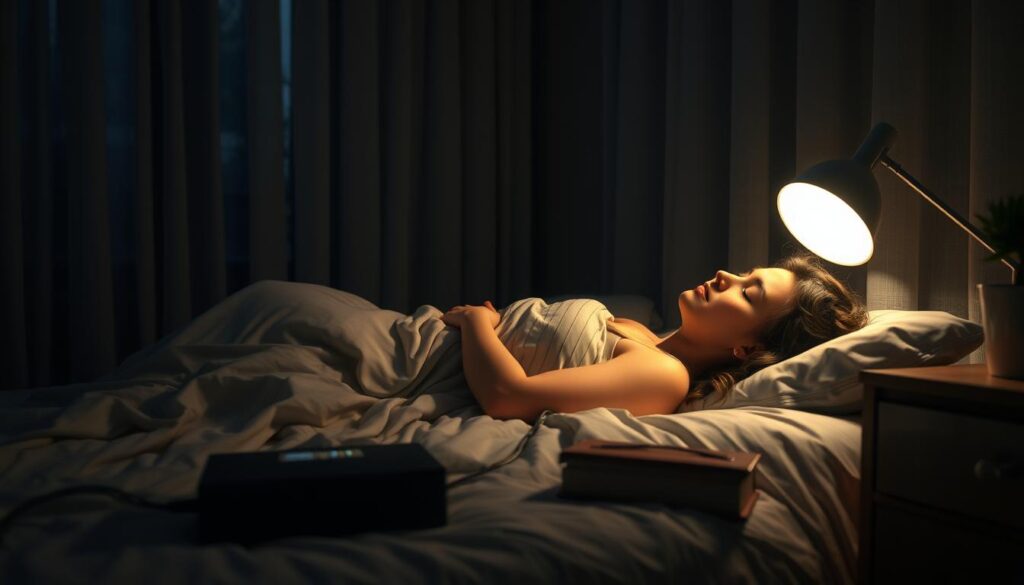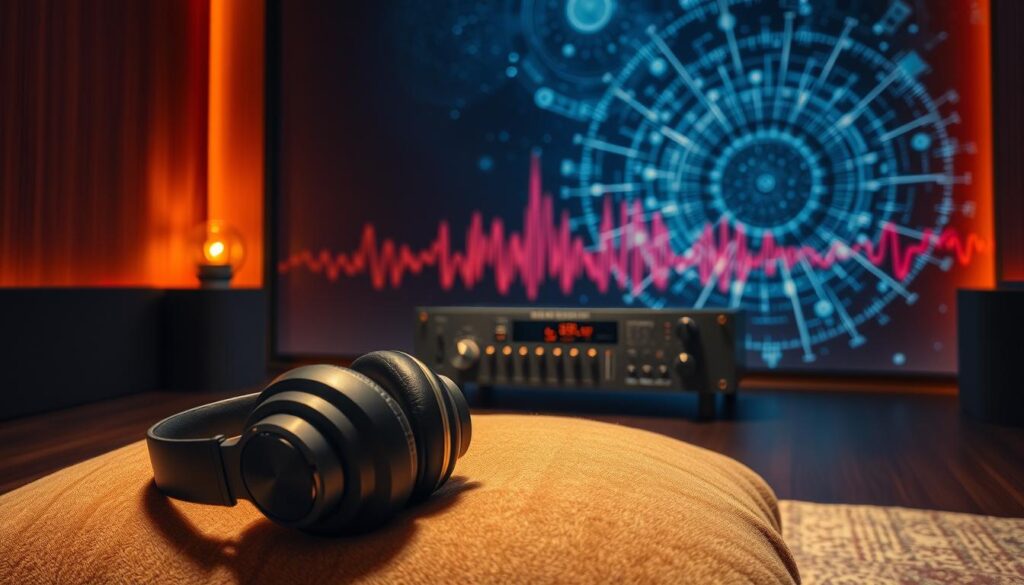Imagine a tool that uses sound to guide your brain into its most restorative state. Binaural beats achieve this by playing two slightly different tones—one in each ear—to create a perceived rhythm. This pulsating effect can align brainwave patterns with frequencies linked to relaxation and recovery.
Research shows the brain naturally syncs with external rhythms through entrainment. When exposed to specific audio patterns, neural activity adjusts to match them. Studies from the Huberman Lab reveal how frequencies near 0.5 Hz mirror slow-wave oscillations during deep non-REM sleep. These waves are critical for memory consolidation and physical restoration.
What makes this approach unique? Unlike higher frequencies, ultra-low tones resonate with the brain’s natural downtime. Techniques like transcranial stimulation use similar principles to enhance sleep quality by reinforcing slow-wave synchronization. The result? A non-invasive method to support the body’s repair processes.
Modern lifestyles often disrupt natural sleep cycles, making solutions like these increasingly valuable. By leveraging science-backed sound therapy, individuals can explore alternatives to traditional sleep aids. This foundation sets the stage for understanding how precise frequencies unlock deeper, more refreshing rest.
Understanding the Science Behind Binaural Beats and Brainwave Patterns
The human brain operates like a symphony of electrical activity, producing distinct rhythms during different states. These neural oscillations—measured as brainwaves—shift from rapid bursts during focus to slow pulses in deep rest. Among these, delta waves dominate during the most restorative phases of non-REM sleep.
Deep Sleep Waves and the Role of Delta Frequencies
Delta waves (0.5-4 Hz) represent the brain’s slowest rhythms, linked to tissue repair and memory storage. During this phase, the body releases growth hormones while filtering toxins from neural pathways. Research shows these frequencies strengthen immune responses and help consolidate memories formed throughout the day.
Entrainment: How the Brain Syncs with External Frequencies
The brain naturally mimics rhythmic stimuli through frequency following response. When exposed to consistent auditory patterns, neurons adjust their firing rates to match. EEG studies reveal that targeted sound stimulation can boost delta wave coherence by up to 27%, enhancing sleep quality without pharmaceuticals.
Individual differences in auditory processing may explain why some respond better to specific tones. However, most users report improved sleep depth when aligning external rhythms with the brain’s natural downtime cycles.
Exploring the Benefits and Practical Applications of Sleep Frequencies

Emerging research reveals how specific sound patterns can transform nightly rest. Targeted audio stimulation offers measurable improvements in both physical recovery and mental clarity. These findings highlight why many now integrate frequency-based practices into their routines.
Enhancing Sleep Quality with Binaural Beats
Binaural beats create a rhythmic effect that helps calm racing thoughts. Studies show users fall asleep 40% faster and experience fewer nighttime interruptions. Reduced cortisol levels correlate with consistent use, easing stress that disrupts rest.
Clinical trials note improved morning alertness in 78% of participants. This aligns with enhanced delta wave activity during deep phases. Shift workers and students particularly benefit from stabilized circadian rhythms.
Research Insights on Frequency Stimulation and Memory Consolidation
Slow-wave synchronization strengthens neural pathways formed during learning. Delta frequencies act like a mental filing system, transferring daily experiences into long-term storage. Older adults using these methods report better recall and cognitive sharpness.
Regular listening builds positive associations with bedtime rituals. This conditioning reduces pre-sleep anxiety by signaling relaxation. Unlike temporary fixes, these techniques address root causes of restless nights.
Optimizing 0.5 Hz for Sleep: Integrating Frequency Listening into Your Bedtime Routine

Crafting an effective nighttime ritual requires balancing sensory input and environmental harmony. Strategic use of delta-range frequencies can amplify the body’s natural wind-down process while reinforcing neural pathways tied to restoration.
Creating an Environment Conducive to Deep Sleep
Begin by minimizing disruptive stimuli 90 minutes before bed. Dim lights to 50 lux or below and maintain room temperatures between 60-67°F. These adjustments signal melatonin production while aligning with the body’s thermal regulation patterns.
Over-ear headphones deliver precise stereo separation for binaural beats. Key setup tips include:
- Setting volume at 30-40 dB (quieter than conversation level)
- Using looped tracks to maintain consistency through sleep cycles
- Positioning speakers at ear level if headphones feel uncomfortable
Combining Meditation and Relaxation Techniques for Restful Nights
Pair frequency listening with four-count breathing exercises. Inhale for four seconds, hold for seven, then exhale for eight. This synchronizes heart rate variability with delta rhythms, enhancing entrainment effects.
Progressive muscle relaxation adds physical dimension to auditory stimulation. Tense and release muscle groups starting from toes to forehead, timed with frequency pulses. Studies show this dual approach reduces sleep latency by 52% compared to sound therapy alone.
Consistency matters most. Stick to the same bedtime window and pre-sleep sequence for 21 days to establish lasting neural associations. Troubleshoot challenges by adjusting track lengths or incorporating white noise buffers for light sleepers.
Final Reflections on Achieving Restorative and Quality Sleep
Harnessing sound’s subtle power transforms how we approach nightly restoration. Binaural beats leverage the brain’s natural responsiveness to rhythmic stimuli, offering science-backed support for those seeking deeper recovery. This method aligns neural activity with delta waves—the slow oscillations governing physical repair and memory storage.
Personalization proves vital. Some notice sharper focus within days, while others require 3-4 weeks of consistent evening sessions. Track progress through morning energy levels or sleep-tracking apps. Adjust track durations or combine with breathwork if initial attempts feel ineffective.
Long-term benefits extend beyond the night. Enhanced rest strengthens immune responses and emotional resilience. It reduces risks tied to chronic fatigue while sharpening daytime performance. View these audio tools as allies within broader health practices—not standalone solutions.
Pair frequency listening with screen curfews and mindful movement. Celebrate small wins, like falling asleep faster or recalling dreams. Over time, the mind learns to associate these rhythms with safety, easing anxiety that disrupts rest. Quality recovery becomes a sustainable practice, not an elusive goal.




